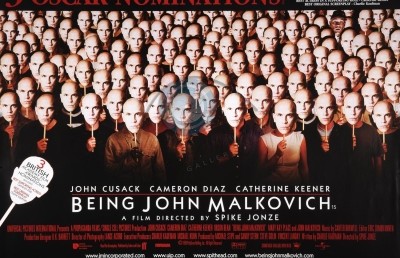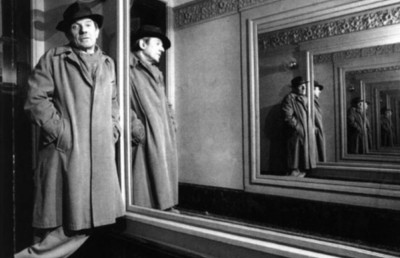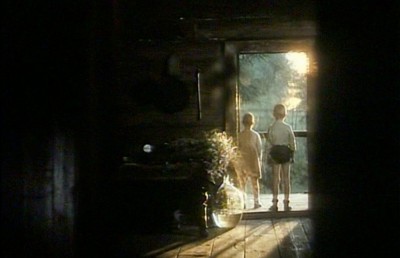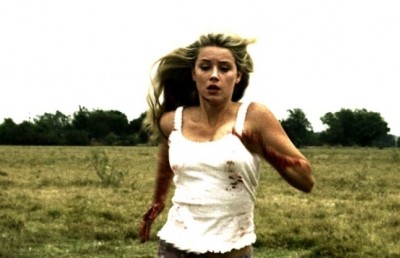Maurice Devereaux at the End of the Line
Interview with Maurice Devereaux
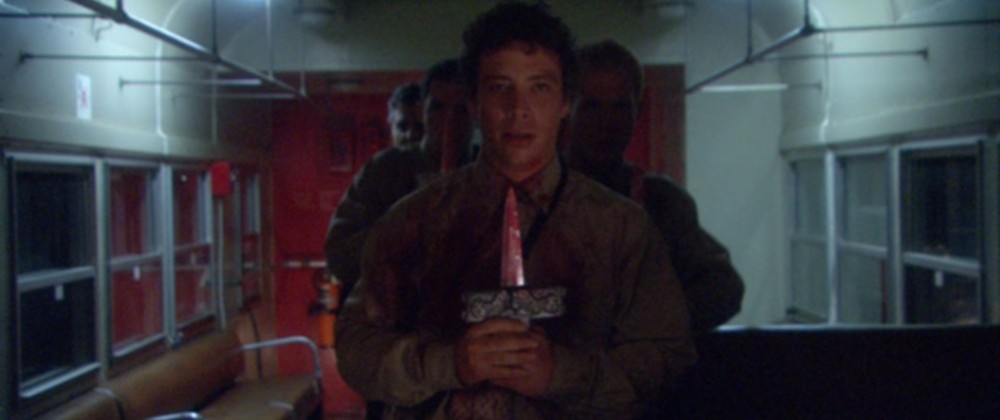
(MAJOR SPOILER ALERT: THIS INTERVIEW CONTAINS MANY STORY SPOILERS, SO I SUGGEST SEEING END OF THE LINE BEFORE READING THIS INTERVIEW.)
Québécois native Maurice Devereaux has been a mainstay of the independent film scene in Montreal since his 1992 debut teen slasher/devil cult worshipping Blood Symbol. Devereaux followed that up with the ghost story The Lady of the Lake (1998), and then with what was his most ambitious film to date, the reality horror/survivalist Slashers (2001). What made Slashers such a demanding feature was its central conceit of appearing to be shot from the single vantage of a live television studio camera. The result is a horror version of the ‘real time’ single shot illusion film, which includes such varied films as Rope, Running Time, Time Code, and The Russian Ark. Slashers deals with a Japanese reality television show in which contestants are chased through a series of maze-like sets by the show’s ‘in-house’ serial killers. The ‘survivor’ wins the cash pot; as such Slashers is notable for being an antecedent of the current survivalist horror craze.
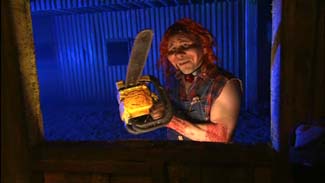
Although Slashers had its own particular set of production difficulties, his next film, the supernatural horror thriller End of the Line (2007), marks an evolution in terms of ambition (more locations, actors), budget and technical sophistication. Thematically, End of the Line taps into one of the most common horror film fears: claustrophobia. In End of the Line this fear of physical entrapment occurs in the underground subway system, where a group of people – Karen (Ilona Elkin), a psychiatric nurse, student Mike (Nicolas Wright), a young couple, John (Tim Rozon) and Sarah (Nina Fillis), an athletic type, Neil (Neil Napier), and a young Asian woman, Julie (Emily Shelton)– become trapped and have to fight for their lives against a group of crazed disciples of a bizarre religious cult (a subject which recalls Devereaux’s debut film Blood Symbol). As the plot develops we learn that this cult, the Voice of Hope, actually believe that by killing people they are saving their souls from the eternal damnation of Armageddon and hence are doing the work of God. The plight of the victim’s becomes even more difficult because cult members may be blending in amongst them.
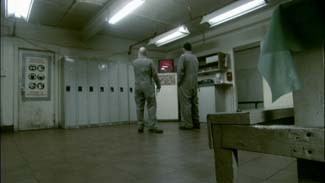
End of the Line goes beyond the run of the mill horror film because its script incorporates a pointed political subtext aimed at the religious right and religious fanaticism. When asked about this in a Montreal weekly, Devereaux responded by saying, “The film comes from a combination of September 11 and my own beef with religious extremes. A cult is a scary thing for me. But really, what I show in the film isn’t that far from reality. Islamic or Christian—religion has been used throughout history to justify some horrible acts.”
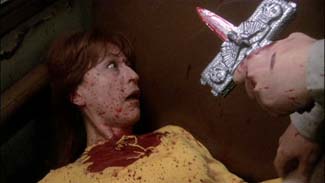
What is also refreshing about the film is that it assumes an intelligent audience willing to decode visual clues that are sprinkled throughout the film. For example, the ending is nicely kept open, with a shadow that moves across Karen’s face signaling that something potentially threatening is standing in front of her, but the camera never reveals the source of the shadow. The viewer is also left to disentangle the multiple layers of meaning with regards the nature of the threat (Is Armageddon really occurring in the world outside the subway? Is the cult actually right in their belief of serving in the name of God? Are the events happening in the way that they appear, or might they be the product of heightened imagination?).
Also, while the film does not pull any punches with the violence, Devereaux mixes the visceral with the psychological, to great effect. For example, the scene between subway employee Frankie (Johnny Vamvas) and his wife Brenda (Lori Graham) is one of the most emotionally compelling in the film, because of the way the otherwise weak Frankie, when forced into making a gut-wrenching decision, actually demonstrates unexpected inner strength by refusing to give in to the cult’s pressure to ‘save’ (i.e. kill) his wife.
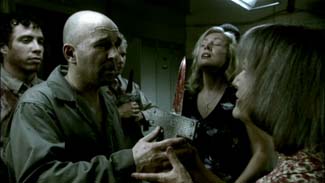
It is hard for me to understand how End of the Line, a film which delivers on every count as an intelligent, scary horror film has yet to receive a theatrical distribution. The trials and tribulations of this hardship is touched on in the following interview with writer/director/producer Maurice Devereaux, which was conducted shortly before the American DVD release of End of the Line.
Offscreen: Can you explain the reason for shooting the subway scenes in Toronto rather than Montreal? You go into the details on the DVD commentary, but can you go through that again? How many of the 21 ½ days were shot in Toronto?
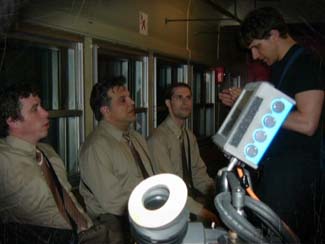
Maurice Devereaux: Only 1 day was shot in the “ghost station’ in Toronto, a no longer in use part of the Bay station, that now serves only for films (like the Matrix). I had tried to approach the Montreal Metro people but they were very uncooperative and were asking for 20 times the amount that Toronto charged, so it was more cost effective to pay for hotel and transportation for the cast and crew and go to Toronto. We only shot the “platform scene” where the main characters wait for the subway, but we didn’t have any actual working subways (as that costs extra) and had to wait every few minutes for the overhead trains to pass above us so we could record sound, which is why many sound takes were ruined. To counter this we would have needed to shoot after closing time from 1AM to 5:30 AM but again that is more expensive. All the rest of the subway shots were either CGI, or filmed outdoors in a train museum or in an abandoned tunnel.
Offscreen: Does EOTL represent your largest budget and longest shooting schedule (not considering the large gaps in shooting time between your earlier films!)?
Maurice Devereaux: Largest budget yes, but still under $500,000, which is nothing when you consider that everyone was paid; but it was FAR from the longest schedule. On my first films, since sometimes cast and crews weren’t paid, we would shoot for many more days, which was quite a luxury (Blood Symbol was over 60 shooting days, Lady of the Lake was about 34 shooting days), but since we were learning and shooting on weekends, we weren’t as efficient. On Slashers it was 26 days, but like End of the Line, everyone was paid.
Offscreen: We spoke once during Fantasia where you gave a very eloquent and personal account of the trials and tribulations of getting horror/fantasy films funded, made and then distributed here in Quebec. I’d like to have your response in print, if only so other filmmakers can commiserate or perhaps to help other young filmmakers.
Maurice Devereaux: Well here in Quebec the government funds our big 35mm theatrical releases, but the decision makers despise horror films. They have a very snobby attitude towards them, so it’s very hard to get one made in that context. Which is why I’ve always had to resort to financing my films from out of my own pocket. And you know so much has changed in the indie film scene, that now it is much easier to make a movie because of digital technology, computer editing etc., but concurrently it is now much more difficult to actually earn a living at it. As distributors now have such an upper hand, as they have many more films to chose from and can offer next to nothing to the eager young budding filmmakers who make very low budget films and are just happy to have their film released and not make any money back. But it is a different story if you have actually gone out and spent some money.
Offscreen: The film has played well at many festivals, won festival prizes, and has received generally positive reviews from some reputable print sources, which makes it even harder to comprehend the problems you are experiencing in getting the film sold and distributed theatrically. It seems almost without precedence. This isn’t really a question but an observation which you can maybe comment on. Do you have any thoughts on why this is happening?
Maurice Devereaux: Not to toot my own horn, but I think End of the Line was one of the best reviewed horror films in years. It had great fan word of mouth and tons of festival exposure, but it’s still not enough these days, because it costs millions of dollars in prints and advertising to launch a film in theatres to compete with the Hollywood blockbusters. Every year one or two films become the Cinderella “lottery winners” and are picked up at a festival and given the star treatment (most famously The Blair Witch Project) but this is a very rare occurrence. When I premiered in Toronto, I did have major companies after me, but they were only offering me sucker deals.
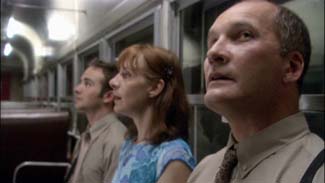
Offscreen: The DVD has already been released in Canada by Critical Mass and Anchor Bay, who are well known for their support of horror. It will be released in the US on DVD in May. Can you talk about how you secured these deals? Will the US DVD be the same as the Canadian release? Will it be uncut? Are there any other markets that the DVD has been sold to?
Maurice Devereaux: In theory the DVD will be the same uncut DVD in the US as the Anchor Bay release with all the same cool extras. This after refusing MANY offers, from many high profile US companies, because they were not offering any MG (minimum guarantee upfront cash advance on profits) or just a very low MG, and this is very dangerous, as many times the MG is the only money you will ever see, as dodgy accounting practices are run of the mill occurrences in the film distribution world. Through William Alexander of Critical Mass Releasing I set up a “wholesale output“ deal with E1 Entertainment (formerly Koch Entertainment) in the US, where I receive a percentage of each unit sold. The film has also received official DVD releases in Japan, Thailand, Vietnam, Germany, Australia, Sweden, and Finland. Upcoming regions are France, Norway, Denmark, Iceland, Belgium, the Netherlands and Luxembourg. Hopefully other territories will follow in 2009, after the US release.
Offscreen: Who designed the cover art for the Canadian DVD? Are you happy with it? I’m not sure it is a good idea to show the demons on the cover, since it might take away from the surprise of seeing them in the film.
Maurice Devereaux: Anchor Bay designed it in part (the bottom half with the cult was my idea and done by my artist friend Donald Caron). Anchor Bay’s graphic design team replaced the top part (which was a screaming face in the form of a cross in our original poster) and added the demons. I agree it is a spoiler, but they were nice enough to ask my opinion and I said OK. I work in publicity so I know that sometimes you have to spoil things in the trailer and poster to help sell the film, so even if I prefer the “less spoiler” posters of other countries (the Japanese and German ones) I respected Anchor Bay’s expertise and opinion that their version would be the most sellable and commercial. Hopefully they are right, as we are using the same one for the US release.
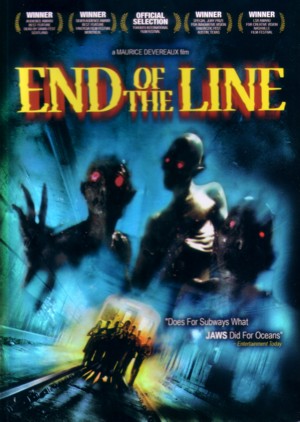
Offscreen: Both Slashers with its illusion of a single take/real time and End of the Line because of its subway location must have generated their own particular production problems. Can you compare the two films in terms of logistical issues? What were the different set of challenges offered by both films? Which was harder (if that can even be quantified)?
Maurice Devereaux: Every film I have ever made was very hard, but on a purely technical level, Slashers was a nightmare because of the “single take” concept. Looking back it was a huge mistake on my part. If I had shot the film in a more traditional manner, and was able to “edit,” everything would have been better, the acting, the lighting, the FX, the pace. I was way too ambitious to want to achieve a single take aesthetic, and it hurt the film tremendously. To this day, I still believe a big budget remake of Slashers would be a huge hit and that my version was a missed opportunity.
End of the Line was very hard, on a personal level. I had a lot of pressure, as I was spending all my savings and the film was, again, very ambitious and I had unfortunate non-filmmaking events happen during the shoot that pushed me to my limit (my girlfriend of 4 years, that I absolutely adored, leaving me mid-shoot, and the death of my father). When I hear Hollywood filmmakers bitch about “the pressure” they were under, I always smile a bit, because I doubt many have lived through the kind of stress I did. I had a deal with the local actor’s union, which was that, in return for a lower rate, I had to pay the entire payroll of every actor in advance before the first day of shooting. But that meant that if for some reason I needed to cancel a day, well the money was already given and there would be no refunds. So when my Dad died, I could not take any time off or else it would have cost me thousands of dollars extra (which I did not have), so I had to go on shooting as if nothing happened. I had to plan the funeral on my lunch hour and schedule it on my “off day.” I did not mention this to anyone except my closest collaborators, as I did not want to create a “depressive” atmosphere on the set. If I could keep my concentration after such a terrible blow, I think I’m up for anything.
Offscreen: Can you go through the evolution of the project, from script to financing, to production and post-production, in terms of length of time for each stage?
Maurice Devereaux: I started the script in 2004 and wrote it in about three months. I then tried to find financing, and sent it to a few contacts I had and didn’t get any responses. One of the hardest things in the world is getting someone to actually read a script. I encountered blocked doors everywhere, so I decided to finance it myself with my own money. I took about three months to cast the film, another 2-3 months to find the locations, then we shot in June of 2005 for about 21 ½ days over a five week period. The editing took longer than it should have because I was working full-time on other jobs (TV commercials), so it took about 7 months to get the first full edit of the film, then about 4 months to do the music, and the mix was about another month.
Offscreen: Do you have a 35mm transfer of the film? If not, how do you negotiate the vast range of projecting facilities that you inevitably encounter with HD? With 35mm film it is universal, but with HD you run into format problems, software problems, aspect ratio problems, not to mention color, brightness, contrast, etc., which were never an issue with good old 35mm. This is a very general question, but to make it more specific. I take it you have seen your film play in many festivals. How has the actual projection quality been across the different venues? Any projection horror stories?
Maurice Devereaux: I’ve seen the film in the best and worst conditions. Some festivals played it off an HDCAM with 5.1 sound from Dolby E or from a DA88 in double system and it was fantastic! Some played it from a DIGITALBETACAM or DVCAM or even DVD in a mono theatre (I didn’t know some of those still existed)…But 35mmm prints are so expensive, and now more and more festivals are equipped with digital projectors. Most of the showings are fine, but usually the sound is never really good, because they are not calibrated for the video decks but only for 35mm prints. But you know, there are many 35mm print issues too (scratches, broken sprockets, missing frames, faded colors, focus problems. etc.) so nothing is perfect.
Offscreen: Your two first films were shot on film and your last two on HD. Does this mean that you have abandoned celluloid forever, or is it simply a question of economics? Do you feel there are any actual aesthetic or stylistic benefits to shooting in HD?
Maurice Devereaux: No if I had the money, I would love to shoot in film again, but I don’t think it will happen. It is just too expensive for me if I’m financing it (if someone else is footing the bill then maybe).
Offscreen: Filmmaking is hard under the best of conditions, so I can only imagine how hard it must have been for you to finish the film, and I applaud you for your great resolve and show of character. I guess with all that happened during and after, End of the Line must have a special meaning for you?
Maurice Devereaux: I feel End of the Line is by far my best film, but it isn’t more special then the others. Every film I made is special to me, they are all my “children” and were all the “light of my life” at the time I was making them. Even if, years later, I can barely watch them, as I’m so embarrassed by all my mistakes. But I loved them all when I was making them and gave them everything I had (literally in a financial sense), all my passion, creativity and time.
Offscreen: One of the things which makes this film different from other cult films is that it leaves open the possibility (as frightening as it may be) that these cult people might be right! Maybe we do need to die to have our soul saved! That must have been a tricky piece of writing?
Maurice Devereaux: The ending was the first thing I wrote. I knew exactly how the film would end, and it really pleases me that people discuss the ending and have different interpretations and heated debates over it. It’s funny how people’s own religious beliefs affect their interpretation of the ending. I find fascinating the very diverse opinions I have heard in person and read on the internet. But, for me, there is a clear cut answer with clues spread out throughout the film of what actually happens at the end. My goal was to have the ending be creepy and seem ambiguous, but it really isn’t. What it is, I won’t say, “that would be telling” to quote the Prisoner, and take away the fun. But the goal was that the film would raise questions and arguments and with repeat viewings, you could actually see different things and change your opinion on how you interpreted certain events, especially the ending.
Offscreen: I have to think that the sex scene on the subway in the beginning between John (Tim Rozon) and Sarah (Nina Fillis) felt like you were having a bit of fun with the typical slasher film sex scene. If so, weren’t you afraid that some people would not see the irony and just read it as an awkward scene?
Maurice Devereaux: Well that scene does elicit a lot of laughs, but I think that the awkwardness is also due to the fact that it’s far from the best scene in the film, no fault of my actors, I just ran out of time on set, and wasn’t able to stage things as well I had hoped. It works for some in the way you mention, but seems ridiculous to others. It makes sense in the grander scheme of things and is part of the “mystery” I had mentioned concerning the ending. But it’s not my favorite scene that’s for sure.
Offscreen: I really like the way the film plays as a straight ahead horror film but leaves open many possible readings or meanings for the events. First of all, are the events really happening or are they a product of a character’s subjectivity (Karen’s?), or of some mind altering substance: the muffins, the writing on the envelope, “Clavicep Purpurea Ergot,” which is a fungi substance known to cause hallucinations. (This was a great clue. The term sounded familiar but I had to google it to find its definition, which fits into your comment on how the film merits and indeed requires, repeat viewings!). And if it is happening, is the cult right about killing as a means of salvation? In terms of the muffins, I was reminded of Hitchcock’s famous notion of the McGuffin, the part of the plot which seems important but is only a trigger to get at something else.
Maurice Devereaux: Since you’ve watched the film more then once and even listened to the commentary track, you are picking up on elements that can be pieced together to solve some of the riddles.
Offscreen: I must congratulate Martin Gauthier’s excellent music. My sense is that the score begins with conventional music (the film’s theme, plain and orchestral) and then as the film progresses evolves to more abstract music and sound design. Is that true? Where did Gauthier gain his inspiration from?
Maurice Devereaux: Thanks, he’ll be very please to read that. I love Martin’s music and he is a joy to work with. I know exactly what kind of music I want to fit the mood of each scene and I push him a lot when I feel something he composed wasn’t exactly what I was looking for, but in the end, he’s always happy I did push him, and we are always very satisfied with the final score. This was our third film together and hopefully we’ll be able to do another.
Offscreen: I watched the film with someone who is a big fan of Carl Sagan and he told me that the title of the book that Mike was reading is “The Demon Haunted World,” which of course fits the theme of the film perfectly and reflects the character’s skepticism. Did you mean more by this or was it just a homage to Sagan, since we can’t actually see the book title very clearly?
Maurice Devereaux: I am a huge Carl Sagan fan, and that book means a lot to me and many of the themes of the film are reflected in his book. I didn’t want to show the book too much, so as not be too “IN YOUR FACE”…
Offscreen: The double murder of Frankie and his pregnant wife Brenda taps into one of the most horrifying moments of cult figure Charles Mansion: the murder of Sharon Tate. Can you talk about why you included this pretty direct reference to that real tragedy?
Maurice Devereaux: Well for me it’s part of the “doublethink” and weird logic that many religious people will use to defend their actions. If it’s OK to kill a doctor who performs abortions, because you’re saving a baby, would it be OK to kill a pregnant female doctor? Or kill (as in this case) a woman who thinks she has Rosemary’s Baby inside her? In the case of the Manson murders, the members of Charlie’s family really believed the people they were butchering “deserved it.” I guess they had to believe it, or else they probably could not have done it. It’s very rare that people see themselves as villains in their own lives. They create stories to justify their actions, it’s easier on their self image I guess.
Offscreen: I know you are a big fan of George Romero, who is undoubtedly one of the most important American horror directors. I saw traces of the Dawn of the Dead music cues in End of the Line, the overall plot tensions from Night of the Living Dead, and thought it clever the way you split the wonderful opening shot of Day of the Dead (Lori Cardille up against the wall/nightmare) to the opening scene (Elkin’s nightmare on the subway) and the end (Elkin up against the wall before the demons attack). Can you talk about the influence of Romero on this film?
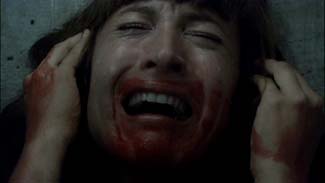
Maurice Devereaux: Oh jeez, his influence is huge. George created the perfect template of entertaining scary horror, filled with subtext that could be interpreted in many ways. And reflected a philosophy where the biggest horror is always human weakness. I am hoping in my own humble way to continue in his footsteps and make films that can entertain and scare but hopefully have something to say.
Offscreen: Are there any other influences you would like to mention (Lamberto Bava & Demons ? Argento? J-Horror? Kubrick?). For example, some of Patrick’s facial ticks (Jack Nicholson), the shots of Neil running with the axe, the low angle shot of Betty at the door, all reminded me of The Shining.
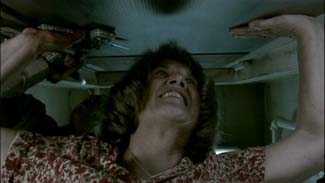
Maurice Devereaux: Of course Kubrick is a genius, and I totally ripped off the shot at the door, but in my defense, we had no room to shoot and it was really the only (and best place) to frame the shot. I debated whether I should do it or not and then thought, what the hell, the best interest of the film supersedes everything. I love Argento, Spielberg, the Coens, Raimi, but so many others have all touched me in so many ways. I hope one day to make a film that would give others as much enjoyment as I got from the films I love.
Offscreen: As a Montrealer I wanted to ask you a specific local question. I think there is a very passionate, dedicated horror film community and subculture here in Montreal. There a quite a few directors who have managed to keep their head above water and continue to make films (feature length or short), like yourself, Mitch Davis, Karim Hussain, Philippe Spurrell, Patrick Tremblay, Izabel Grondin, and others I’m forgetting. There’s the collective Cine-Abbatoir, the local, annual horror festival, DVD and live act spectacle, Spasms, etc. It has definitely been fostered by FanTasia, but there was also a Horror Festival before FanTasia that ran a couple of years in the early 1990s. As a practising filmmaker do you feel a part of this community or are you too wrapped up in the nuts and bolts of everyday? Do you get any kind of energy, inspiration, motivation from this ‘community’?
Maurice Devereaux: Sure, I am lucky that many of the people you mention are friends of mine, and I’ve always said that other filmmakers are not my competition but “my brothers,” and feel that we are all on the same side, fighting to make our dreams a reality. And many times we help each other out.
THANKS!



